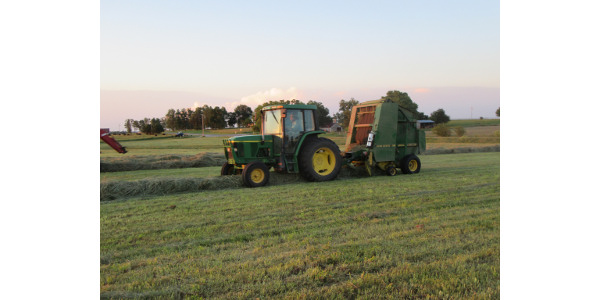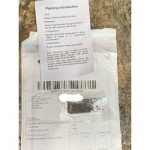Proper equipment settings can provide big payoffs in forage yield, quality
ST. PAUL, Minn. — When it comes to putting up quality hay, the money is in the details. Improper equipment settings can leave hay in the field, add dirt to hay, cause long-term damage to forage stands, and shorten hay storage life. Proper equipment settings can provide big payoffs in maximizing forage yield and quality.
Cutting hay
Cutting height
Forages should be cut at 2.5-3 inches in most conditions to maximize yield and stand longevity. Shorter cutting height results in slightly more yield but decreases quality. Cutting shorter than 2.5 inches increases soil contamination of forage (ash) and shortens stand life of grasses.
Newly-seeded grasses (or mixed stands) should be cut slightly higher (4”) in the establishment year.
Cutterbar settings
Sickle cutterbars
Sickle and guard maintenance is key to minimizing field losses. Adjusting the position and reel speed to match ground speed and crop conditions will minimize field losses, especially in lodged crops.
Rotary cutterbars (disk mowers)
The primary advantage of rotary cutterbars is increased cutting speed. They also improve harvestability of fine-stemmed grasses and lodged forages. Rotary cutterbars create “suction” from the blades which helps pick up lodged forage. The pitch of the cutting knives and angle of the cutterbar influence how much suction is generated. Knives with greater pitch will generate more suction but also suck more dirt into the forage. This dirt increases ash content and reduces forage quality. To minimize soil contamination, use the flattest knife possible that still picks up forage and do not tip the rotary cutterbar down except in lodged forage.
Conditioning hay
Impeller conditioner settings
Impeller conditioners condition the crop with fast-moving “tines” that scratch the stems to allow stem drying. Impeller conditioners are especially effective at conditioning grasses. Compared to roll conditioners, impeller conditioners can have greater leaf losses for broadleaf forage crops like alfalfa. When harvesting alfalfa or broadleaf forage crops, reduce the speed of impellers by 30% to minimize leaf losses. Ensure that the impeller deflector is set so nearly all stems have some abrasion caused by the impeller.
Roll conditioner settings
Roll conditioners are most common for conditioning alfalfa and other broadleaf forages. Roll conditioners are made of intermeshing rubber or steel rolls that crack and squeeze the stems when they pass through. Check roll clearance to ensure it is narrow enough to adequately condition the forage but wide enough to prevent plugging. Refer to the operator’s manual to check for proper adjustment. Proper roll clearance is typically between 1/16 inch and 3/32 inch (verify clearance by passing a rolled up piece of aluminum foil through the rolls, then measuring the thickness with a caliper). Roll pressure should also be great enough to continue cracking stems even when operated at faster speeds.
Swath Width
Make a wide windrow that is at least 70% of the width of the mower (ie. 12ft mower should leave an 8.5 foot wide windrow). Maximizing exposure to sunlight keeps the stomata (small holes in the leaves) open, which allows leaf moisture to quickly evaporate. The goal is to get forage to 60% moisture quickly to halt plant respiration. Respiration burns up starch and sugar reserves that are important to forage quality. Narrow windrows limit sun exposure and shut stomata, allowing forages to burn up more carbohydrates. Narrow windrows can also “sink” into the stubble, limiting air movement and increasing soil contamination.
Raking hay
Rake Type
Mergers, rotary-rakes, and sidebar rakes typically result in less soil contamination in harvested forage compared to wheel rakes. Wheel rakes are often the most cost-effective, but since they roll forage across the ground they also increase soil contamination. Mergers, rotary-rakes, and sidebar rakes “pick up” the forage to varying degrees, keeping forage off the ground and minimizing soil contamination.
Rake Settings
Regardless of rake type, adjust float settings to keep rake tines from scratching the soil. Contact with soil will increase soil contamination and ash content of harvested forage. Raking when forage is 40% moisture or greater will help minimize leaf loss.
Baling hay
Pickup settings
Operating harvesting equipment at the proper PTO and ground speed will minimize pickup losses. This is especially true when harvesting dry alfalfa hay. If ground speed is too slow relative to the pickup speed, the pickup fingers will “comb through” the windrow and knock leaves off. If ground speed is too fast some of the windrow may be left behind. Ensure there are no missing pickup fingers and operate without scratching the soil to minimize pickup losses and soil contamination.
Bale Density
Ensure balers are set up to make dense bales, especially when storing bales outside. Dense bales shed water much better than low-density bales, and improve efficiency of transport and storage.
Net Wrap or Twine?
When making round bales there are obvious productivity advantages to using net wrap. With net wrap, bales can be wrapped in 3 or fewer turns of the bale compared to 20-30 turns with twine. Using net wrap instead of twine can decrease bale chamber losses by up to 1%. Net-wrapped bales also shed water much better when stored outside, resulting in over 30% less dry matter loss compared to twine bales. If twine must be used, space twine less than 6” apart to improve the bale’s ability to shed water.
Storing hay outside?
Poor storage conditions can result in dry matter losses in excess of 50% as well as a reduction in forage quality. For dry hay, water is the enemy. Making large, dense bales wrapped with net-wrap instead of twine will improve storage life when stored outside. Whether hay will be covered or not, store on a well-drained pad in end to end rows. Rows should ideally run north – south and have 3-5 foot spacing between rows to allow uniform sunlight and air movement.
For more information
Visit University of Minnesota Extension’s Forage harvest and storage website.
— Jared Goplen, Extension educator – crops, University of Minnesota
Last modified: 08/04/2020









